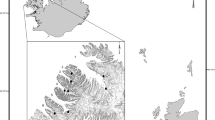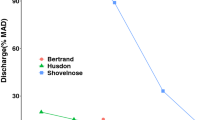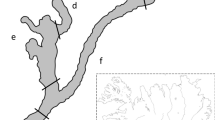Abstract
Increased mortality of juvenile Atlantic salmon (Salmo salar L.), related to lowered levels of stored energy following the loss of ice cover during winter, has been observed after hydropower development in the subarctic River Alta, northern Norway. Drift samples were compared to examine if drift densities, and thus drift prey availabilities for juvenile salmon, were lower in the ice-free than the ice-covered area. In addition, juvenile salmon stomach contents were compared to benthos and drift in the ice-free area to examine salmon winter feeding habitat. Zooplankton, originating from the reservoir, dominated drift at the ice-free site but had lower densities at the downstream ice-covered site. Excluding zooplankton, Chironomidae comprised most of the remaining drift at both the ice-free and ice-covered site, followed by Ephemeroptera, Plecoptera and Simuliidae. No Trichoptera were found in the drift samples. There was no consistent diel periodicity in drift. Benthos was dominated by Chironomidae, followed by Ephemeroptera, Plecoptera and Trichoptera. Other invertebrates occurred in low numbers. Juvenile salmon demonstrated size-selective feeding and fed mainly on Ephemeroptera, followed by Trichoptera and Plecoptera. No zooplankton and few Chironomidae were found in the stomach samples. Stomach content was more similar to benthos than to drift, indicating a larger extent of benthic than drift feeding. No evidence was found for the hypothesis that lack of ice cover reduced the invertebrate drift or caused diel periodicity in the drift. Differences in drift between areas with and without ice could not account for the observed differences in mortality of juvenile salmon during the winter in these areas.





Similar content being viewed by others
References
Allan, J. D., 1982. The effects of reduction in trout density on the invertebrate community of a mountain stream. Ecology 63: 1444–1455.
Amundsen, P.-A., H.-M. Gabler, T. Herfindal & L. S. Riise, 2000. Feeding chronology of Atlantic salmon parr in subarctic rivers: consistency of nocturnal feeding. Journal of Fish Biology 56: 676–686.
Amundsen, P.-A., H.-M. Gabler & L. S. Riise, 2001. Intraspecific food resource partitioning in Atlantic salmon (Salmo salar) parr in a subarctic river. Aquatic Living Resources 14: 257–265.
Assel, R. A., K. Cronk & D. Norton, 2003. Recent trends in Laurentia Great Lake ice-cover. Climatic Change 57: 185–204.
Browman, H. I. & B. M. Marcotte, 1986. Diurnal feeding and prey size selection in Atlantic salmon, Salmo salar, alevins. In Simenstad, C. A. & G. M. Cailliet (eds), Contemporary Studies on Fish Feeding: The Proceedings of Gutshop ‘84. Kluwer Academic Publishers, Dordrecht: 269–284.
Chaston, I., 1969. The light threshold controlling the periodicity of invertebrate drift. Journal of Animal Ecology 38: 171–180.
Clifford, H. F., 1972. A year’s study of the drifting organisms in a brown-water stream of Alberta, Canada. Canadian Journal of Zoology 50: 975–983.
Conover, W. J. & R. L. Iman, 1981. Rank transformations as a bridge between parametric and nonparametric statistics. The American Statistician 35: 124–129.
Cunjak, R. A., 1988. Behaviour and microhabitat of young Atlantic salmon (Salmo salar) during winter. Canadian Journal of Fisheries and Aquatic Sciences 45: 2156–2160.
Cunjak, R. A., T. D. Prowse & D. L. Parrish, 1998. Atlantic salmon (Salmo salar) in winter: “the season of parr discontent”? Canadian Journal of Fisheries and Aquatic Sciences 55: 161–180.
Elliott, J. M., 1965. Daily fluctuations of drift invertebrates in a Dartmoor stream. Nature 205: 1127–1129.
Elliott, J. M., 1967. Invertebrate drift in a Dartmoor stream. Archiv für Hydrobiologie 63: 202–237.
Finstad, A. G. & T. Forseth, 2006. Adaptation to ice-cover conditions in Atlantic salmon Salmo salar L. Evolutionary Ecology Research 8: 1249–1262.
Finstad, A. G., T. Forseth, T. F. Næsje & O. Ugedal, 2004a. The importance of ice cover for energy turnover in juvenile Atlantic salmon. Journal of Animal Ecology 73: 959–966.
Finstad, A. G., O. Ugedal, T. Forseth & T. F. Næsje, 2004b. Energy-related juvenile winter mortality in a northern population of Atlantic salmon (Salmo salar). Canadian Journal of Fisheries and Aquatic Sciences 61: 2358–2368.
Flecker, A. S., 1992. Fish predation and the evolution of invertebrate drift periodicity: evidence from neotropical streams. Ecology 73: 438–448.
Flecker, A. S. & J. D. Allan, 1984. The importance of predation, substrate and spatial refugia in determining lotic insect distributions. Oecologia 64: 306–313.
Fraser, N. H. C. & N. B. Metcalfe, 1997. The cost of becoming nocturnal: feeding efficiency in relation to light intensity in juvenile Atlantic salmon. Functional Ecology 11: 385–391.
Gabler, H.-M., P.-A. Amundsen & T. Herfindal, 2001. Diet segregation between introduced bullhead (Cottus gobio L.) and Atlantic salmon parr (Salmo salar L.) in a sub-Arctic river. Archiv für Hydrobiologie 151: 609–625.
Grader, M. & B. H. Letcher, 2006. Diel and seasonal variation in food habits of Atlantic salmon parr in a small stream. Journal of Freshwater Ecology 21: 503–517.
Heggenes, J., O. M. W. Krog, O. R. Lindås, J. G. Dokk & T. Bremnes, 1993. Homeostatic behavioural responses in a changing environment: brown trout (Salmo trutta) become nocturnal during winter. Journal of Animal Ecology 62: 295–308.
Hildebrand, S. G., 1974. The relation of drift to benthos density and food level in an artificial stream. Limnology and Oceanography 19: 951–957.
Hinterleitner-Anderson, D., A. E. Hershey & J. A. Schuldt, 1992. The effects of river fertilization on mayfly (Baetis sp.) drift patterns and populations density in an arctic river. Hydrobiologia 240: 247–258.
Horn, H. S., 1966. Measurement of “overlap” in comparative ecological studies. American Naturalist 100: 419–424.
Jensen, A. J., 1984. Konsesjonsundersøkelser i Alta-Kautokeinovassdraget 1980-1983: Plankton og drivfauna. Directorate for Nature Management, Trondheim, Report no. 6-1984: 1–47 (in Norwegian).
Jensen, A. J., 2003. Atlantic salmon (Salmo salar) in the regulated River Alta: effects of altered water temperature on parr growth. River Research and Applications 19: 733–747.
Johansen, M., J. M. Elliott & A. Klemetsen, 2000. Diel fluctuations of invertebrate drift in a Norwegian stream north of the Arctic Circle. Norwegian Journal of Entomology 47: 101–112.
Jørgensen, E. H. & M. Jobling, 1992. Feeding behaviour and effect of feeding regime on growth of Atlantic salmon, Salmo salar. Aquaculture 101: 135–146.
Keeley, E. R. & J. W. A. Grant, 1997. Allometry of diet selectivity in juvenile Atlantic salmon (Salmo salar). Canadian Journal of Fisheries and Aquatic Sciences 54: 1894–1902.
Kohler, S. L., 1985. Identification of stream drift mechanisms: an experimental and observational approach. Ecology 66: 1749–1761.
Koksvik, J. I. & H. Reinertsen, 2008. Changes in macroalgae and bottom fauna in the winter period in the regulated Alta River in Northern Norway. River Research and Applications 24: 720–731.
Kramer, C. Y., 1956. Extension of multiple range tests to group means with unequal numbers of replicators. Biometrics 12: 309–310.
Krebs, C. J., 1989. Ecological Methodology. Harper Collins Publishers, New York.
Magnuson, J. J., D. M. Robertson, J. B. Benson, R. H. Wynne, D. M. Livingstone, T. Arai, R. A. Assel, R. G. Barry, V. Card, E. Kuusisto, N. G. Granin, T. D. Prowse, K. M. Stewart & V. S. Vuglinski, 2000. Historical trends in lake and river ice-cover in the Northern hemisphere. Science 289: 1743–1746.
Martin, M. D., R. S. Brown, D. R. Barton & G. Power, 2001. Abundance of stream invertebrates in winter: seasonal changes and effects of river ice. Canadian Field-Naturalist 115: 68–74.
McLay, C. L., 1968. A study of drift in the Kakanui River, New Zealand. Australian Journal of Marine and Freshwater Research 19: 139–149.
Müller, K., 1965. Field experiments on periodicity of freshwater invertebrates. In Aschoff, J. (ed.), Circadian Clocks. North-Holland Publishing, Amsterdam: 314–317.
Nislow, K. H., C. L. Folt & M. Seandel, 1998. Food and foraging behaviour in relation to microhabitat use and survival of age-0 Atlantic salmon. Canadian Journal of Fisheries and Aquatic Sciences 55: 116–127.
Pennuto, C. M., F. deNoyelles, M. A. Conrad, F. A. Vertucci & S. L. Dewey, 1998. Winter macroinvertebrate communities in two montane Wyoming streams. Great Basin Naturalist 58: 231–244.
Petersen, R. C., G. M. Gíslason & L. B. M. Vought, 1995. Rivers of the Nordic countries. In Cushing, C. E., K. W. Cummins & G. W. Minshall (eds), River and Stream Ecosystems. Elsevier Scientific, Amsterdam: 295–341.
Reiriz, L., A. G. Nicieza & F. Braña, 1998. Prey selection by experienced and naive juvenile Atlantic salmon. Journal of Fish Biology 53: 100–114.
Thonney, J.-P. & R. J. Gibson, 1989. Feeding strategies of brook trout, Salvelinus fontinalis, and juvenile Atlantic salmon, Salmo salar, in a Newfoundland river. Canadian Field-Naturalist 103: 48–56.
Tukey, J. W., 1949. Comparing individual means in the analysis of variance. Biometrika 5: 99–114.
Turcotte, P. & P. P. Harper, 1982. Drift patterns in a high Andean stream. Hydrobiologia 89: 141–151.
Ugedal, O., E. B. Thorstad, A. G. Finstad, P. Fiske, T. Forseth, N. A. Hvidsten, A. J. Jensen, J. I. Koksvik, H. Reinertsen, L. M. Saksgård & T. F. Næsje, 2007. Biologiske undersøkelser i Altaelva 1981-2006. Oppsummering av kraftreguleringens konsekvenser for laksebestanden. NINA Rapport 281: 1–106 (in Norwegian).
Ugedal, O., T. F. Næsje, E. B. Thorstad, T. Forseth, L. M. Saksgård & T. G. Heggberget, 2008. Twenty years of hydropower regulation in the River Alta: long-term changes in abundance of juvenile and adult Atlantic salmon. Hydrobiologia 609: 9–23.
Wallace, R. K., 1981. An assessment of diet-overlap indexes. Transactions of the American Fisheries Society 110: 72–76.
Wankowski, J. W. J. & J. E. Thorpe, 1979. Spatial distribution and feeding in Atlantic salmon (Salmo salar L.) juveniles. Journal of Fish Biology 14: 239–247.
Waringer, J. A., 1992. The drifting of invertebrates and particulate organic matter in an Austrian mountain brook. Freshwater Biology 27: 367–378.
Waters, T. F., 1962. Diurnal periodicity in the drift of stream invertebrates. Ecology 43: 316–320.
Acknowledgements
The study was financed by Statkraft Energy AS and the Norwegian Institute for Nature Research (NINA). We thank Alta Laksefiskeri Interessentskap, Trond Andreassen, Svein Ole Arnesen, Marc Daverdin, Tor Knudsen, Ivar Leinan, Tormod Leinan, Randi Saksgård and Rune Øiangen for assistance during field and laboratory work, and the associated editor and anonymous referees for constructive comments on the manuscript.
Author information
Authors and Affiliations
Corresponding author
Additional information
Handling editor: S. Stendera
Rights and permissions
About this article
Cite this article
Johansen, M., Thorstad, E.B., Rikardsen, A.H. et al. Prey availability and juvenile Atlantic salmon feeding during winter in a regulated subarctic river subject to loss of ice cover. Hydrobiologia 644, 217–229 (2010). https://doi.org/10.1007/s10750-010-0118-x
Received:
Revised:
Accepted:
Published:
Issue Date:
DOI: https://doi.org/10.1007/s10750-010-0118-x




